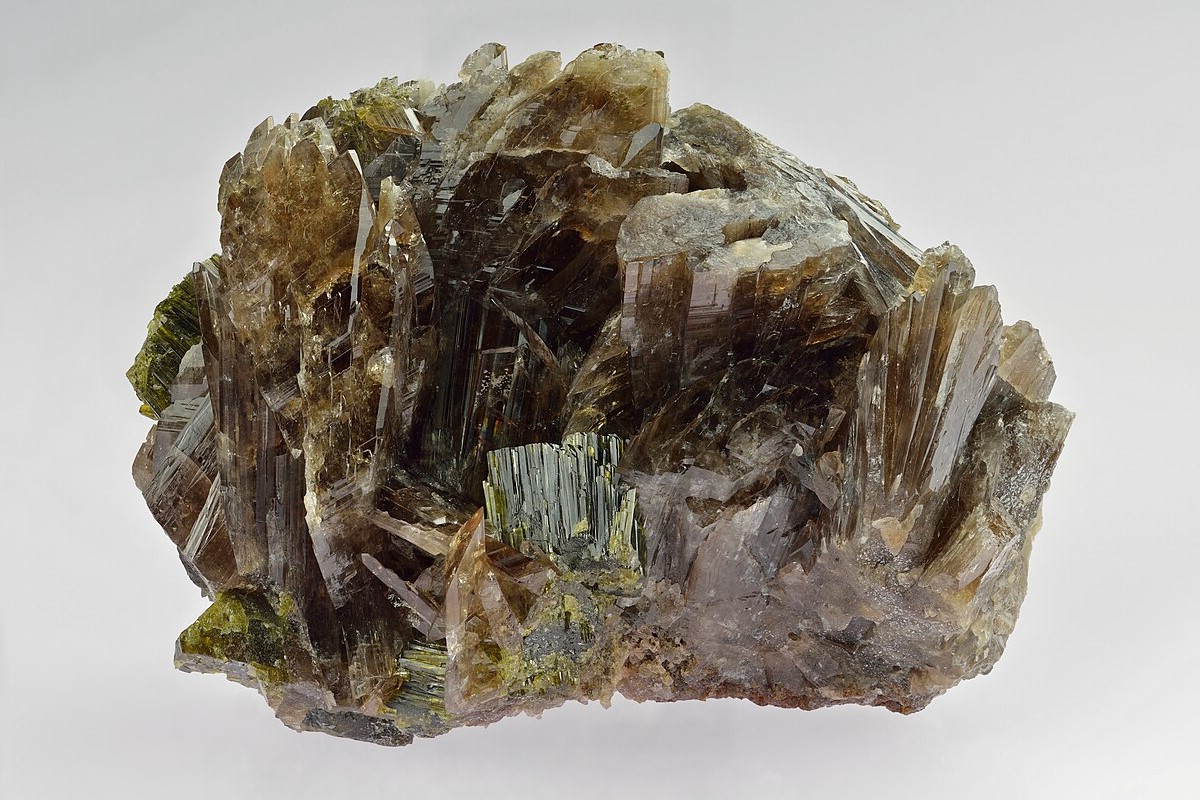
Axinite is a captivating mineral that often catches the eye with its unique crystal formations and vibrant colors. Found in various parts of the world, this gemstone is not just a pretty face; it has a rich history and fascinating properties that make it a favorite among collectors and geologists alike. What makes Axinite so special? Its ability to form in a range of colors, from deep browns to purples, and its unique crystal structure set it apart from other minerals. Whether you're a seasoned gem enthusiast or just curious about the natural world, learning about Axinite can be both educational and exciting. Let's dive into 50 intriguing facts about this remarkable mineral!
Key Takeaways:
- Axinite is a stunning mineral with blade-like crystals and vibrant colors. It's found in places like France, the US, and Russia, and is used in jewelry, meditation, and scientific research.
- With a unique crystal structure and piezoelectric properties, axinite is not just a collector's item but also has practical uses in jewelry, meditation, and scientific research. It's found in various locations around the world, including France, the US, and Russia.
What is Axinite?
Axinite is a fascinating mineral known for its unique crystal structure and vibrant colors. This gemstone is often sought after by collectors and gem enthusiasts.
- Axinite is a group of borosilicate minerals.
- It typically forms in metamorphic rocks.
- The name "Axinite" comes from the Greek word "axine," meaning "axe," due to its blade-like crystal shape.
- Common colors include brown, violet, and green.
- Axinite crystals are usually transparent to translucent.
- It has a Mohs hardness of 6.5 to 7.
- Axinite has a vitreous luster, giving it a glassy appearance.
- It is often found in association with other minerals like quartz and calcite.
- The mineral is piezoelectric, meaning it can generate an electric charge under mechanical stress.
- Axinite is also pyroelectric, producing an electric charge when heated.
Where is Axinite Found?
Axinite can be found in various locations around the world, each offering unique specimens.
- Notable deposits are found in France, particularly in the Alps.
- The United States has significant axinite sources in California.
- Mexico is another country with notable axinite deposits.
- Russia, especially in the Ural Mountains, is known for its axinite.
- Axinite has also been discovered in Brazil.
- Japan is home to some unique axinite specimens.
- Madagascar is another location where axinite is mined.
- Sri Lanka has produced some high-quality axinite crystals.
- Australia, particularly in Tasmania, has axinite deposits.
- Pakistan is known for its axinite, especially in the Gilgit-Baltistan region.
Uses of Axinite
Axinite is not just a collector's item; it has practical uses as well.
- It is often used in jewelry, especially in rings and pendants.
- Axinite's unique colors make it a popular choice for decorative items.
- Some believe axinite has metaphysical properties, promoting grounding and balance.
- It is used in crystal healing practices.
- Axinite is sometimes used in meditation to enhance focus.
- The mineral's piezoelectric properties make it useful in scientific research.
- Axinite can be cut into cabochons for ornamental purposes.
- It is also used in making gemstone carvings.
- Collectors prize axinite for its rarity and beauty.
- Museums often display axinite specimens due to their unique crystal formations.
Physical Properties of Axinite
Understanding the physical properties of axinite can help identify and appreciate this mineral.
- Axinite has a specific gravity of 3.28 to 3.37.
- It exhibits perfect cleavage in one direction.
- The crystal system of axinite is triclinic.
- Axinite crystals are often wedge-shaped or tabular.
- It has a refractive index ranging from 1.675 to 1.704.
- Axinite can show pleochroism, displaying different colors when viewed from different angles.
- The mineral can fluoresce under ultraviolet light.
- Axinite has a brittle tenacity, meaning it can break or chip easily.
- It often forms in hydrothermal veins.
- Axinite can also be found in skarn deposits.
Interesting Facts About Axinite
Here are some intriguing tidbits about axinite that might surprise you.
- Axinite was first described in 1797 by French mineralogist René Just Haüy.
- The largest axinite crystal ever found weighed over 100 kilograms.
- Axinite is sometimes mistaken for other minerals like tourmaline or garnet.
- The mineral's unique crystal shape makes it a favorite among mineralogists.
- Axinite can sometimes contain inclusions of other minerals, adding to its uniqueness.
- Some axinite crystals have been found with phantom inclusions, showing earlier stages of crystal growth.
- The mineral's name has been used in various fictional works due to its exotic sound.
- Axinite is often used in educational settings to teach about crystal structures.
- The mineral's piezoelectric properties have been studied for potential technological applications.
- Axinite's vibrant colors and unique shapes make it a popular subject for photography.
The Final Word on Axinite
Axinite, with its unique crystal structure and vibrant colors, offers a fascinating glimpse into the world of minerals. From its formation in metamorphic rocks to its use in jewelry, this mineral has captured the interest of geologists and gem enthusiasts alike. Its piezoelectric properties make it not just a pretty face but also a functional one in various technological applications. Whether you're a collector, a scientist, or someone who just loves beautiful stones, axinite has something to offer. Its rarity and distinctive features make it a prized addition to any collection. So next time you come across this intriguing mineral, you'll know a bit more about what makes it so special. Keep exploring and who knows, you might just find your own piece of axinite to treasure.
Frequently Asked Questions
Was this page helpful?
Our commitment to delivering trustworthy and engaging content is at the heart of what we do. Each fact on our site is contributed by real users like you, bringing a wealth of diverse insights and information. To ensure the highest standards of accuracy and reliability, our dedicated editors meticulously review each submission. This process guarantees that the facts we share are not only fascinating but also credible. Trust in our commitment to quality and authenticity as you explore and learn with us.


